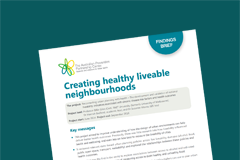Creating healthy liveable neighbourhoods
This project reviewed state-based urban planning policies across five liveability domains (alcohol, food, public open space, transport, walkability) and explored the relationships between these policies and health outcomes. Download the Findings Brief PDF to learn how important liveability measures are for health.
Key messages
- This project aimed to improve understanding of how the design of urban environments can help deliver better health outcomes. Previously, there was little research into how liveability influenced health and wellbeing, and even less on how best to measure the liveability of cities.
- It reviewed relevant state-based urban planning policies across five liveability domains (alcohol, food, public open space, transport, walkability) and explored the relationships between these policies and health outcomes.
- The project was the first in the world to explore associations between access to alcohol and self-rated health, and it developed a new way of measuring access to both healthy and unhealthy food.
- The team created liveability measures across the five domains that policy makers can use to plan urban areas that promote health, for example:
- The recommended ratio to promote health is no more than one fast food outlet for every four supermarkets/green grocers
- Public transport stops within 400m of homes and with at least two services per hour were associated with greater levels of walking for transport.
- The project developed a set of indicators that can be used to benchmark and monitor progress towards creating liveable communities that promote health and reduce health inequities.
- This set of measures is intended to be a tool for anyone involved in creating healthy neighbourhoods, such as governments, developers, public health planners, and researchers.


